THE GREATEST OBSTACLE the modern photographer encounters is his adherence to an idea that the camera "holds a mirror up to nature," that it is "true to nature." If that were so, photography would be for all times contained among the sciences and debarred from art. For nature is never art, nor does nature as a whole ever affect us as art. In art we are dealing strictly with the mental and emotional faculties more or less developed in each individual. These faculties respond when, on a flat surface such as paper, we find certain emotional and intellectual records of things we have seen or experienced in nature. And it is the manner in which these records are made that affects us as art. Every stroke, touch, spot, and patch of light and dark governed by the mind and hand of the artist interprets first an emotion, second a meaning. In this lies the province of art. The "mirror of nature," as expressed by photography, is a cold, impersonal, undesirable tracing of certain facts reproduced by pure science — heartless, uninteresting. Its value is wholly scientific, and it deals with only one kind of truth. There is nothing impressionable or impressive about it. Pictorial art is strongly emotional. It exists to give pleasure and at the same time knowledge; not such knowledge as the dissecting sciences impart, but the kind inherent in music, poetry, literature, religion.— Art principles in portrait photography (1907), by Walter Beck, p. 18-19
Nature in itself has nothing to do with art; it is only the quarry, the reservoir out of which material for art can be taken. It is plain, then, that "true to nature" cannot refer to the comprehensive truth, but that of necessity selection of truths must be resorted to in any event. This being so, the phrase "holding a mirror up to nature" is evidently meaningless from the standpoint of art, and "true to nature" must be understood as referring to a phase of nature of which we have become conscious.
Tuesday, April 12, 2011
Photography as an Art
Thursday, April 7, 2011
Frequently Asked Questions
HERE ARE A FEW questions photographers often get from the public.
Q: What kind of camera should I get?
What do you want to do with it?
Oh, I don't know. I think that I would like to get into photography. It might be a fun hobby; I've always been creative.
I would suggest getting a cheap one, a camera that has just the basics and manual override. A camera store can help you with this. Get a camera cheap enough so that you won't get buyer's remorse or get too upset if you drop and break it. Also get some inexpensive photo editing software for your computer, as well as an introductory book on photography. Play with the camera and software, and follow the examples in the book to see if you like photography. Maybe after six months you will find that you want to upgrade your camera, or you will find out that you aren't interested in pursuing it further. In any case, your investment is insignificant.
Q: What kind of filter do I need to protect my lens?
None.
You have to very careful with the kind of filter you use, for cheap filters will optically degrade your images, sometimes severely. If you do need one, B+W filters are highly regarded.
But if you spent so much on a lens that you worry about damaging it, then you ought to worry about image quality degradation — otherwise a cheaper lens would suit your purposes. Be careful in handling it, and a rigid lens hood and lens cap is your best protection against damage. I would use a filter only if it is needed creatively (like using polarizers to cut reflections or darken blue skies), or if you are in a salt-air environment.
Q: I want to get my wife the ultimate anniversary present. What is the best camera you can buy?
Might I suggest the Nikon D3x? It is very popular with professionals and takes superb photos. You will need a variety of lenses to go with it. I would suggest getting the 400mm f/2.8G lens for taking photos of wildlife, the 200mm f/2G for indoor sports pictures, the 14-24mm f/2.8G, a wide angle lens, particularly suitable for taking photos indoors, the 135mm f/2.0 DC and the 85mm f/1.4 for taking portraits, the 60mm f/2.8G Micro lens for close-ups, and the 28-300mm zoom lens for general purpose use.
Please click the links above to purchase. My associate will provide you with excellent service.
Q: I have a bunch of 512 MB CF cards. I want to buy a new camera that will use these.
Why do I hear this question so often?
The card you use in a camera is really not that important. Buy whatever card the new camera uses. You will find that the new cards are cheap, and are likely faster and more capacious than your old cards.
Q: How do I get good bokay?
Perhaps you mean bokeh? The word bokeh comes from Japanese, and is used to describe the quality of background blur in an image.
These factors contribute to getting a stronger background blur: getting closer to the subject, opening up the lens aperture, using a longer focal length, and using a camera with a larger sensor. Now the quality of the background blur can be harsh or creamy, and this depends of the lens design itself; some lenses, especially those made for portraiture, will have better bokeh than others, and will be priced accordingly.
Q: My wife has a Nikon D3x camera and 7 lenses that she wants to sell because they are too big and heavy to be practical. Where can I get a good price for used equipment?
You can sell your equipment to Adorama or B&H Photo. These large dealers are likely to give good prices for high-end equipment.
Q: Thinkin about turnin pro. What camera do pro's use? Is $200 too much to charge for a wedding?
Professionals use whatever camera they want to use. And $200 is way too much for you to charge for a wedding.
Q: What DPI setting should I use for my photos?
The dots per inch setting does not matter at all, and it will have no effect whatsoever when you print out your photos or display them on your computer. All that matters is the pixel dimensions of your image. Too few pixels will look terrible if you attempt to make a large print of an image.
DPI does matter when you submit your photos to a commercial publisher. Typically book and magazine publishers will specify a fixed DPI setting: usually 300 dots per inch. When you submit your photo, they will not resize your photo at all, they will merely crop it to fit. For this reason, the publisher will specify both an image size and a DPI size, and your camera must have enough pixels to ensure that your image will cover this size. They will typically specify a size larger than they will use, to allow for bleed off the edge of the paper and to give them flexibility of layout. As a photographer, this is actually very helpful, for you process your image as you want it to look: resizing photos can degrade quality greatly.
Q: What kind of camera do I need to take good indoor pictures of my kids?
Are you having problems?
Yeah, my current camera is slow and my kids are fast. If I do manage to get a photo, either the photo is really grainy, or the kids are blurry, or the flash goes off and the picture doesn't look all that great.
I would suggest getting a low-end DSLR. Most large electronics retailers and camera stores will have fairly inexpensive cameras from Canon, Nikon, and other manufacturers that will solve your problem.
DSLRs in general produce superior results because they have larger sensors than compact cameras. This reduces the problem you see with grain and blur and reduces the need for a flash. Because these cameras have a mirror and separate viewfinder, they are able to incorporate a much faster focusing mechanism than what is found in compacts.
The trade-off is that these cameras are bulkier and heavier, so I would recommend going to the store and trying it out yourself. Usually, people get used to the larger size fairly quickly and the quality improvement is usually worth it.
The lens that comes with your camera is probably adequate. However, you may want to spend about $100 more and get a fast lens, like a 50mm f/1.8. This will let in more light and will allow you to avoid blurring and avoid using the flash in dimmer light.
Q: Why are my interior photos yellow?
That is due to the relatively yellow color of lighting used inside.Your camera has a built-in automatic white balance which attempts to correct for the color of light, but it doesn't always work well. Take at look at my article White Balance, Part 1.
You might try manually setting your camera to incandescent, tungsten, or fluorescent; just remember to set it back to automatic when you are done.
For really good work, you can calibrate the camera to match the lighting precisely. For this you need a target that is guaranteed to be neutral in color. Click here for an inexpensive card.
Q: I want a compact camera with excellent image quality but I don't want a DSLR.
Well, that will be a problem. DSLRs, due to their design, will produce better...
I just told you that I don't want a DSLR! Don't you listen? Or are you just stupid? I want a compact camera that will take as good pictures as a DSLR.
Your options are limited — it could be quite expensive —
Money is no object.
Well, in that case, might I recommend the Leica M9? Like DSLRs, it incorporates superb interchangeable lenses, among the best in the industry, and it has a full-frame sensor like those found in the highest-quality DSLRs. Because of its compact size and silent shutter, it is prized by photojournalists who need to be discrete. And may I suggest an assortment of lenses to go with it...
Um — well — sorry. I'm afraid that is a little beyond my budget. Can you recommend something else?
I think the Sony NEX-5 or the Fuji X-100 would be perfect for you. Not quite as flexible or high performance as a DSLR, but both of these will deliver excellent image quality similar to a DSLR in a compact size. You might also investigate the Micro 4/3rds cameras, which have smaller sensors than DSLRs, but offer much greater quality than typical compacts.
Q: Black and white photography is obsolete. Why don't you get it?
What are you talking about?
Color is where it's at now. Black and white was merely a product of historical forces, ignorance, and technological compromises, and so it has no relevance to us today; black and white photography is something that ought to be abandoned and forgotten.
This sounds familiar. See my article Black and White.
Q: Why do my pictures look washed out?
What do you mean by washed out?
Well, I'm not really sure. But the colors are disappointing. They are pale. The sky is often white instead of blue.
It sounds like your photos are overexposed — that is really common. Take a look at your camera's manual and look up the exposure override function. If your colors look pale, then try adjusting the camera to expose the picture less — -2/3 E.V. would be a good start. You can also try to increase the saturation in the camera, but don't do too much of it. Take a look at my article Three Opportunities for Overexposure.
Unfortunately you now risk underexposing your shots — your pictures could look dark and muddy instead of washed out. See if your camera has a histogram feature: you want to be sure that your histograms don't show too much or too little exposure.
Q: Help! I was told to set my camera to Adobe RGB so that I can capture brighter colors, and now my colors are all muted!
Well, don't do that then.
Most cameras and computers use the sRGB color standard, which can capture about 35% of all colors. Adobe RGB is useful since it can capture 50% of all colors: but if you don't know how to handle managed color workflows on your computer then I wouldn't bother. See my article Imaginary and Impossible Colors.
Q: Should I use RAW or JPEG?
RAW is technically superior, but you are forced to do more work on the computer. Do you want to do no work at all on the computer, and will you do all your work in the camera? Or do you want to spend extra time sitting in front of your computer making your images look right? If you are going to do photo editing anyway, then shooting in RAW is useful since it gives you more flexibility in adjusting white balance and exposure.
Be aware that Adobe Camera RAW, as found in Photoshop and Lightroom, will not produce the same results as the camera's own JPEG. For this reason, I usually use Nikon's View NX2 software to do my RAW conversion before moving the image into Photoshop.
Q: What kind of camera do I need for sports?
If you are shooting sports outdoors in the daytime, an inexpensive point-and-shoot camera with a decent zoom lens should be adequate. If you are shooting sports indoors or at night, you will likely need a DSLR with a fast telephoto lens. This will be quite expensive to do well, and it would be far cheaper to hire someone to do it for you.
Q: What settings do I use to take pictures at night?
I can't tell you that, but your camera and your eyes can tell you. If you are far away from artificial lighting, set your camera's white balance to daylight, otherwise set it to tungsten or incandescent. Put your camera on a tripod. Set the self-timer, and let the camera make whatever exposure it wants. You may find that the camera can't focus, you will have to figure out the camera's manual focus feature. If the camera tells you it is too dark, and you have a manual exposure feature, then use it. Adjust the exposure time until the image on the screen looks good to you. Your exposure could be several minutes long or longer. See the Wikipedia article Exposure Value for hints.
Q: Can you recommend a good lightweight tripod?
I can recommend a good tripod or a light tripod, but not a good light tripod. If you are serious about providing a solid platform for your camera, I would recommend getting a heavy tripod, and a tall one at that. You don't want to lean over all the time to take pictures, and a high camera angle is sometimes superior. A heavy tripod will likely be both sturdier and much more stable than a light one. Having extreme stability is important when taking long exposures, such as at night or in dim interiors.
I've had bad experiences with light tripods. Vibrations from people walking across the floor, a truck rumbling outside, the wind blowing, or even the weight of the camera itself can ruin a photo.
Q: What kind of camera should I get?
What do you want to do with it?
Oh, I don't know. I think that I would like to get into photography. It might be a fun hobby; I've always been creative.
I would suggest getting a cheap one, a camera that has just the basics and manual override. A camera store can help you with this. Get a camera cheap enough so that you won't get buyer's remorse or get too upset if you drop and break it. Also get some inexpensive photo editing software for your computer, as well as an introductory book on photography. Play with the camera and software, and follow the examples in the book to see if you like photography. Maybe after six months you will find that you want to upgrade your camera, or you will find out that you aren't interested in pursuing it further. In any case, your investment is insignificant.
Q: What kind of filter do I need to protect my lens?
None.
You have to very careful with the kind of filter you use, for cheap filters will optically degrade your images, sometimes severely. If you do need one, B+W filters are highly regarded.
But if you spent so much on a lens that you worry about damaging it, then you ought to worry about image quality degradation — otherwise a cheaper lens would suit your purposes. Be careful in handling it, and a rigid lens hood and lens cap is your best protection against damage. I would use a filter only if it is needed creatively (like using polarizers to cut reflections or darken blue skies), or if you are in a salt-air environment.
Q: I want to get my wife the ultimate anniversary present. What is the best camera you can buy?
Might I suggest the Nikon D3x? It is very popular with professionals and takes superb photos. You will need a variety of lenses to go with it. I would suggest getting the 400mm f/2.8G lens for taking photos of wildlife, the 200mm f/2G for indoor sports pictures, the 14-24mm f/2.8G, a wide angle lens, particularly suitable for taking photos indoors, the 135mm f/2.0 DC and the 85mm f/1.4 for taking portraits, the 60mm f/2.8G Micro lens for close-ups, and the 28-300mm zoom lens for general purpose use.
Please click the links above to purchase. My associate will provide you with excellent service.
Q: I have a bunch of 512 MB CF cards. I want to buy a new camera that will use these.
Why do I hear this question so often?
The card you use in a camera is really not that important. Buy whatever card the new camera uses. You will find that the new cards are cheap, and are likely faster and more capacious than your old cards.
Q: How do I get good bokay?
Perhaps you mean bokeh? The word bokeh comes from Japanese, and is used to describe the quality of background blur in an image.
These factors contribute to getting a stronger background blur: getting closer to the subject, opening up the lens aperture, using a longer focal length, and using a camera with a larger sensor. Now the quality of the background blur can be harsh or creamy, and this depends of the lens design itself; some lenses, especially those made for portraiture, will have better bokeh than others, and will be priced accordingly.
Q: My wife has a Nikon D3x camera and 7 lenses that she wants to sell because they are too big and heavy to be practical. Where can I get a good price for used equipment?
You can sell your equipment to Adorama or B&H Photo. These large dealers are likely to give good prices for high-end equipment.
Q: Thinkin about turnin pro. What camera do pro's use? Is $200 too much to charge for a wedding?
Professionals use whatever camera they want to use. And $200 is way too much for you to charge for a wedding.
Q: What DPI setting should I use for my photos?
The dots per inch setting does not matter at all, and it will have no effect whatsoever when you print out your photos or display them on your computer. All that matters is the pixel dimensions of your image. Too few pixels will look terrible if you attempt to make a large print of an image.
DPI does matter when you submit your photos to a commercial publisher. Typically book and magazine publishers will specify a fixed DPI setting: usually 300 dots per inch. When you submit your photo, they will not resize your photo at all, they will merely crop it to fit. For this reason, the publisher will specify both an image size and a DPI size, and your camera must have enough pixels to ensure that your image will cover this size. They will typically specify a size larger than they will use, to allow for bleed off the edge of the paper and to give them flexibility of layout. As a photographer, this is actually very helpful, for you process your image as you want it to look: resizing photos can degrade quality greatly.
Q: What kind of camera do I need to take good indoor pictures of my kids?
Are you having problems?
Yeah, my current camera is slow and my kids are fast. If I do manage to get a photo, either the photo is really grainy, or the kids are blurry, or the flash goes off and the picture doesn't look all that great.
I would suggest getting a low-end DSLR. Most large electronics retailers and camera stores will have fairly inexpensive cameras from Canon, Nikon, and other manufacturers that will solve your problem.
DSLRs in general produce superior results because they have larger sensors than compact cameras. This reduces the problem you see with grain and blur and reduces the need for a flash. Because these cameras have a mirror and separate viewfinder, they are able to incorporate a much faster focusing mechanism than what is found in compacts.
The trade-off is that these cameras are bulkier and heavier, so I would recommend going to the store and trying it out yourself. Usually, people get used to the larger size fairly quickly and the quality improvement is usually worth it.
The lens that comes with your camera is probably adequate. However, you may want to spend about $100 more and get a fast lens, like a 50mm f/1.8. This will let in more light and will allow you to avoid blurring and avoid using the flash in dimmer light.
Q: Why are my interior photos yellow?
That is due to the relatively yellow color of lighting used inside.Your camera has a built-in automatic white balance which attempts to correct for the color of light, but it doesn't always work well. Take at look at my article White Balance, Part 1.
You might try manually setting your camera to incandescent, tungsten, or fluorescent; just remember to set it back to automatic when you are done.
For really good work, you can calibrate the camera to match the lighting precisely. For this you need a target that is guaranteed to be neutral in color. Click here for an inexpensive card.
Q: I want a compact camera with excellent image quality but I don't want a DSLR.
Well, that will be a problem. DSLRs, due to their design, will produce better...
I just told you that I don't want a DSLR! Don't you listen? Or are you just stupid? I want a compact camera that will take as good pictures as a DSLR.
Your options are limited — it could be quite expensive —
Money is no object.
Well, in that case, might I recommend the Leica M9? Like DSLRs, it incorporates superb interchangeable lenses, among the best in the industry, and it has a full-frame sensor like those found in the highest-quality DSLRs. Because of its compact size and silent shutter, it is prized by photojournalists who need to be discrete. And may I suggest an assortment of lenses to go with it...
Um — well — sorry. I'm afraid that is a little beyond my budget. Can you recommend something else?
I think the Sony NEX-5 or the Fuji X-100 would be perfect for you. Not quite as flexible or high performance as a DSLR, but both of these will deliver excellent image quality similar to a DSLR in a compact size. You might also investigate the Micro 4/3rds cameras, which have smaller sensors than DSLRs, but offer much greater quality than typical compacts.
Q: Black and white photography is obsolete. Why don't you get it?
What are you talking about?
Color is where it's at now. Black and white was merely a product of historical forces, ignorance, and technological compromises, and so it has no relevance to us today; black and white photography is something that ought to be abandoned and forgotten.
This sounds familiar. See my article Black and White.
Q: Why do my pictures look washed out?
What do you mean by washed out?
Well, I'm not really sure. But the colors are disappointing. They are pale. The sky is often white instead of blue.
It sounds like your photos are overexposed — that is really common. Take a look at your camera's manual and look up the exposure override function. If your colors look pale, then try adjusting the camera to expose the picture less — -2/3 E.V. would be a good start. You can also try to increase the saturation in the camera, but don't do too much of it. Take a look at my article Three Opportunities for Overexposure.
Unfortunately you now risk underexposing your shots — your pictures could look dark and muddy instead of washed out. See if your camera has a histogram feature: you want to be sure that your histograms don't show too much or too little exposure.
Q: Help! I was told to set my camera to Adobe RGB so that I can capture brighter colors, and now my colors are all muted!
Well, don't do that then.
Most cameras and computers use the sRGB color standard, which can capture about 35% of all colors. Adobe RGB is useful since it can capture 50% of all colors: but if you don't know how to handle managed color workflows on your computer then I wouldn't bother. See my article Imaginary and Impossible Colors.
Q: Should I use RAW or JPEG?
RAW is technically superior, but you are forced to do more work on the computer. Do you want to do no work at all on the computer, and will you do all your work in the camera? Or do you want to spend extra time sitting in front of your computer making your images look right? If you are going to do photo editing anyway, then shooting in RAW is useful since it gives you more flexibility in adjusting white balance and exposure.
Be aware that Adobe Camera RAW, as found in Photoshop and Lightroom, will not produce the same results as the camera's own JPEG. For this reason, I usually use Nikon's View NX2 software to do my RAW conversion before moving the image into Photoshop.
Q: What kind of camera do I need for sports?
If you are shooting sports outdoors in the daytime, an inexpensive point-and-shoot camera with a decent zoom lens should be adequate. If you are shooting sports indoors or at night, you will likely need a DSLR with a fast telephoto lens. This will be quite expensive to do well, and it would be far cheaper to hire someone to do it for you.
Q: What settings do I use to take pictures at night?
I can't tell you that, but your camera and your eyes can tell you. If you are far away from artificial lighting, set your camera's white balance to daylight, otherwise set it to tungsten or incandescent. Put your camera on a tripod. Set the self-timer, and let the camera make whatever exposure it wants. You may find that the camera can't focus, you will have to figure out the camera's manual focus feature. If the camera tells you it is too dark, and you have a manual exposure feature, then use it. Adjust the exposure time until the image on the screen looks good to you. Your exposure could be several minutes long or longer. See the Wikipedia article Exposure Value for hints.
Q: Can you recommend a good lightweight tripod?
I can recommend a good tripod or a light tripod, but not a good light tripod. If you are serious about providing a solid platform for your camera, I would recommend getting a heavy tripod, and a tall one at that. You don't want to lean over all the time to take pictures, and a high camera angle is sometimes superior. A heavy tripod will likely be both sturdier and much more stable than a light one. Having extreme stability is important when taking long exposures, such as at night or in dim interiors.
I've had bad experiences with light tripods. Vibrations from people walking across the floor, a truck rumbling outside, the wind blowing, or even the weight of the camera itself can ruin a photo.
Saturday, April 2, 2011
Three Opportunities to Underexpose
SPRING IS FINALLY here in Saint Louis, and we have spring's floral finery waiting for the camera.
When you photograph brightly colored flowers, be aware that you risk overexposure:
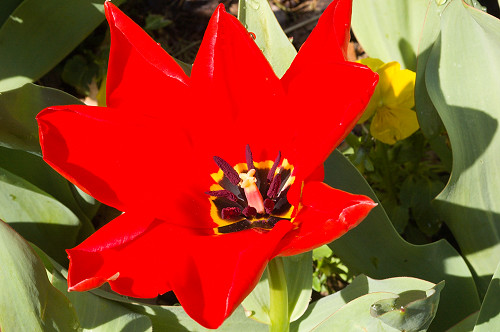
Overexposing bright colors is easy with digital photography — and also when using film for slides. This red color really isn't all that bright compared to pure white, for it is only a bit more luminous than a middle gray. But digital cameras can only record so much red before they become overwhelmed. Blue skies are often overexposed, as we see in the article Three Opportunities for Overexposure.
As we see here, even a slight overexposure can ruin an image; adding contrast or saturation (common settings in a camera that usually make images look better) will make matters worse. Just by looking at this photo you should be able to tell that it is overexposed: we have a large, nearly featureless areas of bright primary and secondary colors, namely the red tulip as well as section of the yellow flower on the right.
The color of each pixel in this image is determined by three numbers, each of which range in value from 0 to 255, with the numbers determining the amount of red, green, and blue light at each pixel. For an overview of this RGB color system, see the article Color Spaces, Part 1: RGB. Variation of the RGB color numbers across the image gives us detail: but here, much of the red tulip has its red value pegged at 255. So the flower looks flat and largely void of detail.
Overexposure in and of itself is not necessarily bad, and it is often unavoidable, but you likely will want to avoid overexposing even a single color channel on your main subject, like this tulip. If your digital camera offers three separate color histograms, you may want to check it to avoid this problem. Here are the overexposed portions, shown masked in black:
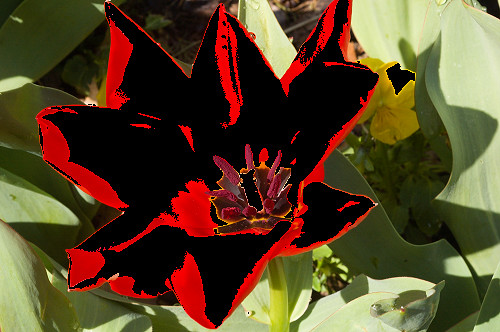
I took another photo nearby, using better exposure:
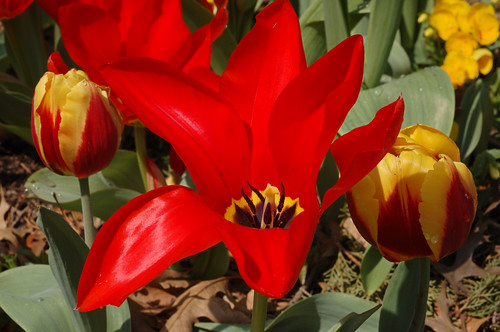
I took these photos the other day at the Missouri Botanical Garden in Saint Louis. You can see more of my photos taken that day here.
The red channel just barely kisses 255 in the brightest red areas, and so this flower, unlike the one above, is not overexposed. But this image is still disappointing. While we do see detail and texture in the flower, it still looks somewhat flat, especially compared to the adjoining tulips. The yellow parts of those tulips look more interesting and textured. What is going on here?
Here are the three color channels of this image:
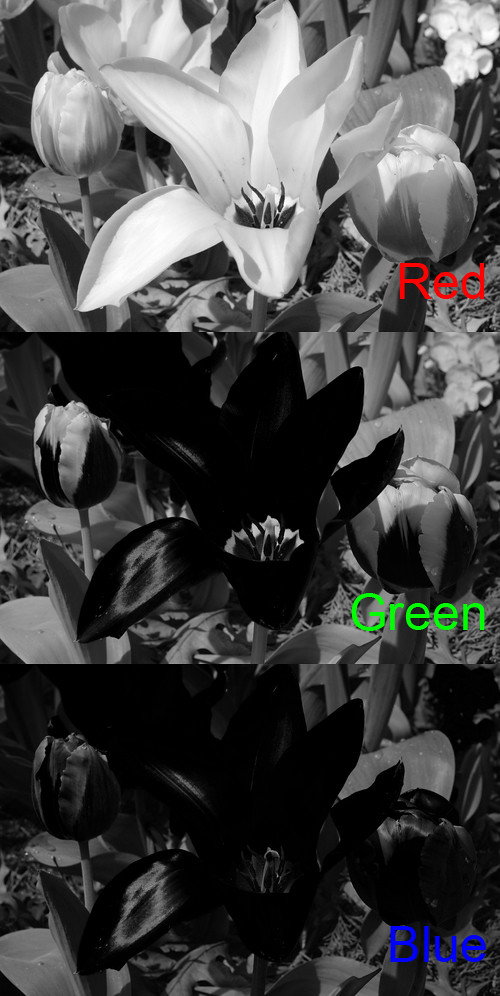
Please note that nearly all of the red tulip is black in the green and blue channels. As we would expect, there is good detail in the red channel. Take a look at the yellow parts of the tulip on the left; it shows good detail in all three channels, and so it has nice texture in the final color image.
We see texture when there is variation of the RGB color channels across an area. If there is little variation around a point, we see little texture at that point. Variation in color shows texture, but we have little to no variation in color with the red tulip. Variation in luminosity or brightness is typically more important when you want to show texture. See my article Luminance is More Important than Color.
A rough model of luminosity is:
Underexposure then is not one thing, but rather is three things, for we need to be concerned with the exposure of all three color channels. Typically we do not expect to see detail in black or white areas of a photograph, but certainly we would like to see texture in mid tones. But as we see here, we cannot count on that. Because two of our channels are underexposed, we lost texture.
I might add that the color of the tulip is wrong. It was not that particular shade of red, rather it was more intense, closer to scarlet, closer to the far edge of human color perception.
Just by looking at the RGB color numbers, we see that G and B are zero, and so all color is determined by R alone. This means that the color of the tulip is fixed to the color of the sRGB red primary. The sRGB standard is used by most digital cameras and most computer monitors.
The sRGB color standard can display only about 35% of all possible colors, as illustrated here:
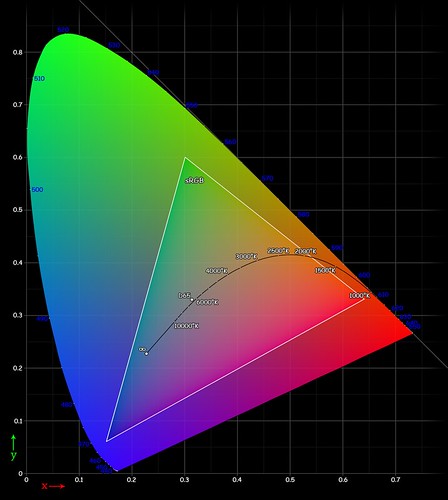
This image originally appeared on Wikipedia. Source and attribution: http://en.wikipedia.org/wiki/File:Cie_Chart_with_sRGB_gamut_by_spigget.png
The horseshoe shape shows the limit of human color vision. The sRGB color gamut is represented by the triangle in this diagram. Our tulip color is somewhat near the lower righthand corner of this chart. Of course, this chart itself is not accurate in color, because it uses the sRGB standard, and so the outlying colors, outside of the triangle, cannot be displayed.
In photography, whenever you get one or two RGB colors at 255, while the other color is zero, then you know that you are out of gamut. We even see this in our first, overexposed photo. Red is largely fixed at 255, while blue and green are zero.
One solution is to capture the image using a color standard that is larger than sRGB. We won't be able to see these extra colors here, because lots of web browsers and computer monitors are limited to the sRGB standard. We can use a wider color gamut when printing, especially if use a higher-end printer than uses more than three color inks.
As it happens, I took this image using Camera RAW, and my Nikon can capture a very broad range of colors. During post-processing on my computer, I can convert the RAW file to sRGB, or I can convert it to the ProPhoto colorspace, which can represent more colors:
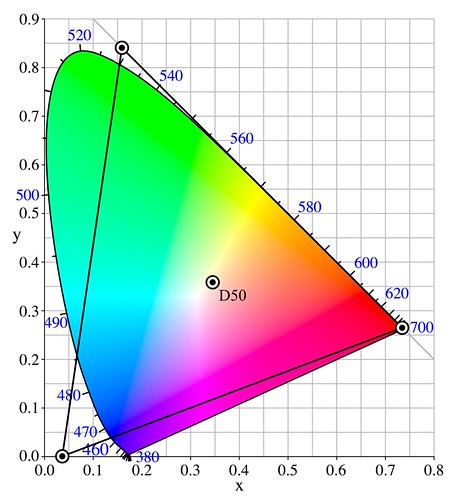
Image originally appeared on Wikipedia. Source and attribution: http://en.wikipedia.org/wiki/File:CIExy1931_ProPhoto.png
Notice the much larger triangle here, and also note that the red primary goes all the way to the limit of human vision; undoubtably our tulip can be accurately captured.
Here I edited the photo after converting the RAW image to the ProPhoto colorspace.
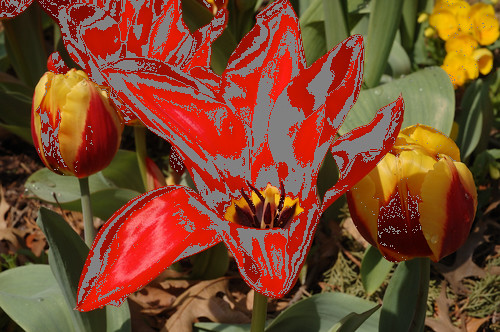
The gray here approximately indicates the areas which cannot be represented by sRGB. If we look at all three color channels, we can see that there is good texture in the tulip:
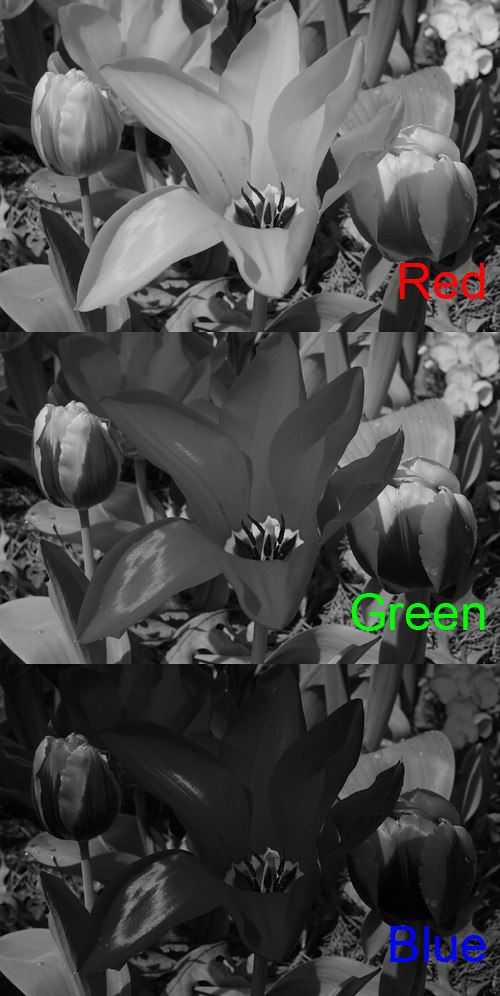
While we cannot show the ProPhoto image on the computer screen in all its glory, it may be printable, depending on the kind of printer we use. The final image ought to have better texture than what we had before.
We could process this image for computer display if we are willing to desaturate the red in the ProPhoto image. This would give us better texture at the expense of color.

Here I used the good green and blue channels from the ProPhoto color gamut to add texture back into the tulip. The flower is no longer intensely red, but I think it is otherwise a slight improvement.
When you photograph brightly colored flowers, be aware that you risk overexposure:

Overexposing bright colors is easy with digital photography — and also when using film for slides. This red color really isn't all that bright compared to pure white, for it is only a bit more luminous than a middle gray. But digital cameras can only record so much red before they become overwhelmed. Blue skies are often overexposed, as we see in the article Three Opportunities for Overexposure.
As we see here, even a slight overexposure can ruin an image; adding contrast or saturation (common settings in a camera that usually make images look better) will make matters worse. Just by looking at this photo you should be able to tell that it is overexposed: we have a large, nearly featureless areas of bright primary and secondary colors, namely the red tulip as well as section of the yellow flower on the right.
The color of each pixel in this image is determined by three numbers, each of which range in value from 0 to 255, with the numbers determining the amount of red, green, and blue light at each pixel. For an overview of this RGB color system, see the article Color Spaces, Part 1: RGB. Variation of the RGB color numbers across the image gives us detail: but here, much of the red tulip has its red value pegged at 255. So the flower looks flat and largely void of detail.
Overexposure in and of itself is not necessarily bad, and it is often unavoidable, but you likely will want to avoid overexposing even a single color channel on your main subject, like this tulip. If your digital camera offers three separate color histograms, you may want to check it to avoid this problem. Here are the overexposed portions, shown masked in black:

I took another photo nearby, using better exposure:

I took these photos the other day at the Missouri Botanical Garden in Saint Louis. You can see more of my photos taken that day here.
The red channel just barely kisses 255 in the brightest red areas, and so this flower, unlike the one above, is not overexposed. But this image is still disappointing. While we do see detail and texture in the flower, it still looks somewhat flat, especially compared to the adjoining tulips. The yellow parts of those tulips look more interesting and textured. What is going on here?
Here are the three color channels of this image:

Please note that nearly all of the red tulip is black in the green and blue channels. As we would expect, there is good detail in the red channel. Take a look at the yellow parts of the tulip on the left; it shows good detail in all three channels, and so it has nice texture in the final color image.
We see texture when there is variation of the RGB color channels across an area. If there is little variation around a point, we see little texture at that point. Variation in color shows texture, but we have little to no variation in color with the red tulip. Variation in luminosity or brightness is typically more important when you want to show texture. See my article Luminance is More Important than Color.
A rough model of luminosity is:
Luminosity = 30% red + 59% green + 11% blueIf you want to show lots of texture or detail, then this calculated luminosity has to strongly vary over an area. With our tulip the majority of the green and blue color values are zero — seen as black in the above illustration — and so these color channels do nothing to give us texture. The texture in the red channel is attenuated by more than two thirds, and so the image looks somewhat flat.
Underexposure then is not one thing, but rather is three things, for we need to be concerned with the exposure of all three color channels. Typically we do not expect to see detail in black or white areas of a photograph, but certainly we would like to see texture in mid tones. But as we see here, we cannot count on that. Because two of our channels are underexposed, we lost texture.
I might add that the color of the tulip is wrong. It was not that particular shade of red, rather it was more intense, closer to scarlet, closer to the far edge of human color perception.
Just by looking at the RGB color numbers, we see that G and B are zero, and so all color is determined by R alone. This means that the color of the tulip is fixed to the color of the sRGB red primary. The sRGB standard is used by most digital cameras and most computer monitors.
The sRGB color standard can display only about 35% of all possible colors, as illustrated here:

This image originally appeared on Wikipedia. Source and attribution: http://en.wikipedia.org/wiki/File:Cie_Chart_with_sRGB_gamut_by_spigget.png
The horseshoe shape shows the limit of human color vision. The sRGB color gamut is represented by the triangle in this diagram. Our tulip color is somewhat near the lower righthand corner of this chart. Of course, this chart itself is not accurate in color, because it uses the sRGB standard, and so the outlying colors, outside of the triangle, cannot be displayed.
In photography, whenever you get one or two RGB colors at 255, while the other color is zero, then you know that you are out of gamut. We even see this in our first, overexposed photo. Red is largely fixed at 255, while blue and green are zero.
One solution is to capture the image using a color standard that is larger than sRGB. We won't be able to see these extra colors here, because lots of web browsers and computer monitors are limited to the sRGB standard. We can use a wider color gamut when printing, especially if use a higher-end printer than uses more than three color inks.
As it happens, I took this image using Camera RAW, and my Nikon can capture a very broad range of colors. During post-processing on my computer, I can convert the RAW file to sRGB, or I can convert it to the ProPhoto colorspace, which can represent more colors:

Image originally appeared on Wikipedia. Source and attribution: http://en.wikipedia.org/wiki/File:CIExy1931_ProPhoto.png
Notice the much larger triangle here, and also note that the red primary goes all the way to the limit of human vision; undoubtably our tulip can be accurately captured.
Here I edited the photo after converting the RAW image to the ProPhoto colorspace.

The gray here approximately indicates the areas which cannot be represented by sRGB. If we look at all three color channels, we can see that there is good texture in the tulip:

While we cannot show the ProPhoto image on the computer screen in all its glory, it may be printable, depending on the kind of printer we use. The final image ought to have better texture than what we had before.
We could process this image for computer display if we are willing to desaturate the red in the ProPhoto image. This would give us better texture at the expense of color.

Here I used the good green and blue channels from the ProPhoto color gamut to add texture back into the tulip. The flower is no longer intensely red, but I think it is otherwise a slight improvement.
Subscribe to:
Comments (Atom)